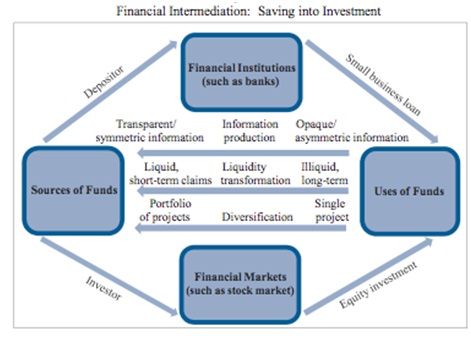Blog Post
Blogs review: What’s finance for?
What’s at stake: Since the financial crisis, the role of finance has been put into question. Beyond the political process of re-regulation, it is useful to go back to the fundamental questions on the role of financial intermediation on growth, employment, risk sharing, etc. Does finance allocate capital efficiently, and allow better inter-temporal consumption and investments decisions or does it concentrate risks, create volatility, and increase inequality? Whether you look at its share of GDP or of profits, finance has undoubtedly become bigger over the last decade? Should something be done about it? The crisis and the Occupy Wall Street movement have renewed the urgency of these questions and the responses might drive the policy agenda over the next few years.
What’s at stake: Since the financial crisis, the role of finance has been put into question. Beyond the political process of re-regulation, it is useful to go back to the fundamental questions on the role of financial intermediation on growth, employment, risk sharing, etc. Does finance allocate capital efficiently, and allow better inter-temporal consumption and investments decisions or does it concentrate risks, create volatility, and increase inequality? Whether you look at its share of GDP or of profits, finance has undoubtedly become bigger over the last decade? Should something be done about it? The crisis and the Occupy Wall Street movement have renewed the urgency of these questions and the responses might drive the policy agenda over the next few years.
What financial intermediation does?
The 2010 Economic Report to the President had a really well written chapter exploring what financial intermediaries do, how their composition evolved over the last 30 years and outlined the different kinds of contagion that they can be prone to. The diagram below summarizes what financial intermediaries do to perform their main function: transforming savings into investment. Financial intermediation uses either markets (like the stock market) or institutions (like a bank) to channel savings into investment. In each of these cases, financial intermediaries provide three important services – information production, liquidity transformation, and diversification – that help decrease problems of adverse selection and moral hazard.

Larger but not better
Brad DeLong points that in 1950, finance and insurance in the United States accounted for 2.8% of GDP, according to US Department of Commerce estimates. By 1960, that share had grown to 3.8% of GDP, and reached 6% of GDP in 1990. Today, it is 8.4% of GDP, and it is not shrinking. In fact, the 2010 share was higher than the previous peak share in 2006. If the US were getting good value from the extra 5.6% of GDP that it is now spending on finance and insurance – the extra $750 billion diverted annually from paying people who make directly useful goods and provide directly useful services – it would be obvious in the statistics. At a typical 5% annual real interest rate for risky cash flows, diverting that large a share of resources away from goods and services directly useful this year is a good bargain only if it boosts overall annual economic growth by 0.3% – or 6% per 25-year generation.
Thomas Philippon (see here for the full paper) argues that, despite all of its fast computers and credit derivatives, the current financial system is no better at transferring funds from savers to borrowers than the financial system of 1910. The sum of all profits and wages paid to financial intermediaries represents the cost of financial intermediation. The measure of this cost from 1870 to 2010, as a share of GDP shows large historical variations. The cost of intermediation grows from 2% to 6% from 1870 to 1930. It shrinks to less than 4% in 1950, grows slowly to 5% in 1980, and then increases rapidly to almost 9% in 2010. He then uses a neoclassical growth model to compute the output contribution of the financial sector. Surprisingly, the model suggests that the finance industry has become less efficient: the unit cost of intermediation is higher today than it was a century ago. Improvements in information technology seem to have been cancelled out by increases in trading activities whose social value is difficult to assess.
Andrew Haldane and Vasileios Madouros at the Bank of England argue that high pre-crisis returns to banking simply increased risk-taking across the sector. This was not an outward shift in the portfolio possibility set of finance. Instead, it was a traverse up the high wire of risk and return. This hire-wire act involved, on the asset side, rapid credit expansion, often through the development of poorly understood financial instruments. On the liability side, this ballooning balance sheet was financed using risky leverage, often at short maturities. Bearing risk is not, by itself, a productive activity. For the Eurozone as a whole, adjusting for risk-taking would reduce the estimated output of the financial sector by about 25-40 % relative to the current methodology.
James Kwak points that the main reason why finance’s share of GDP has outstripped its production of intermediation services, according to Philippon, is a huge increase in trading volumes in recent years. Trading, of course, generates fees for financial institutions, with limited marginal social benefits. Yes, we need some trading to have price discovery. But if I sell you a share of Apple on top of the other 33 million shares that were traded today, is that really helping determine what the price of Apple should be?
Jeff Madrick in a recent book reviewed here by Paul Krugman and Robin Wells, and criticized here by Tyler Cowen, argues that deregulation and financial innovation has mainly allowed to increase the size of the financial sector rather than its services to the rest of the economy.
Lorenzo Bini-Smaghi pointed in 2010 that recent research at the ECB has shown that while a deep financial sector leads to more optimal economic diversification, when it becomes “too large”, its contribution to diversification is substantially weakened (see here). And in an emerging strand of academic literature, some authors have looked at such secondary measures of “financial market size” as excessive profits. They have shown that excessive rents reaped by the financial industry lead to increased risk-taking, which can endogenously generate boom and bust episodes (see here). Others have argued that high relative wages in the financial sector can lead to lower rates of long-term economic growth by attracting “talent” away from the productive sectors of the economy.
Regulatory failures: then and now
Simon Johnson argues that Congress is about to repeat the same deregulation mistakes this time abandoning much of the 1930s-era securities legislation that both served investors well and helped make the US one of the best places in the world to raise capital with the so-called JOBS bill. The idea behind the JOBS bill is that our existing securities laws – requiring a great deal of disclosure – are significantly holding back the economy. The bill, HR3606, received bipartisan support in the House (only 23 Democrats voted against). The bill’s title is JumpStart Our Business Startup Act, a clever slogan – but also a complete misrepresentation.
Felix Salmon argues that Dodd-Frank, it seems, was a brief aberration. Now, we’re back to business as usual, and a captured Congress. A bill which was essentially drafted by a small group of bankers and financiers has managed to get itself widespread bipartisan support, even as it rolls back decades of investor protections. That wouldn’t have been possible a couple of years ago, and I’m unclear what has changed. But one thing is coming through loud and clear: anybody looking to Congress to be helpful in the fight to have effective regulation of financial institutions, is going to be very disappointed. Much more likely is that Congress will be actively unhelpful, and will do whatever the financial industry wants in terms of hobbling regulators and deregulating as much activity as it possibly can.
In a new book, James Barth, Jerry Caprio and Ross Levine point to the overarching regulatory failure, where regulators lacked the incentives and the political clout to act. They make the point that this is fundamentally a problem of the right public: the only constituency able to understand and influence the problems faced by regulators are banks and financial markets. The public is too far from the field, and cannot pressure policymakers to do more. They suggest the establishment of a “Sentinel” (the comic-minted people will prefer to call them the Watchmen) to provide an informed, expert, and independent assessment of financial regulation. It would require publishing information about regulatory activity, and thus forcing democratic pressure on the regulation agencies.
Felix Salmon noted that unexpectedly, an offshoot of “Occupy Wall Street” called “Occupy the SEC” wrote a 300-pages long report criticizing the implementation of the Volcker rule by the Congress. It is highly detailed and technical, and shows that time might be ripe to have financial stability emerge as a subject with an informed public able to pressure policymakers to act.
*Bruegel Economic Blogs Review is an information service that surveys external blogs. It does not survey Bruegel’s own publications, nor does it include comments by Bruegel authors.
Republishing and referencing
Bruegel considers itself a public good and takes no institutional standpoint. Anyone is free to republish and/or quote this post without prior consent. Please provide a full reference, clearly stating Bruegel and the relevant author as the source, and include a prominent hyperlink to the original post.



